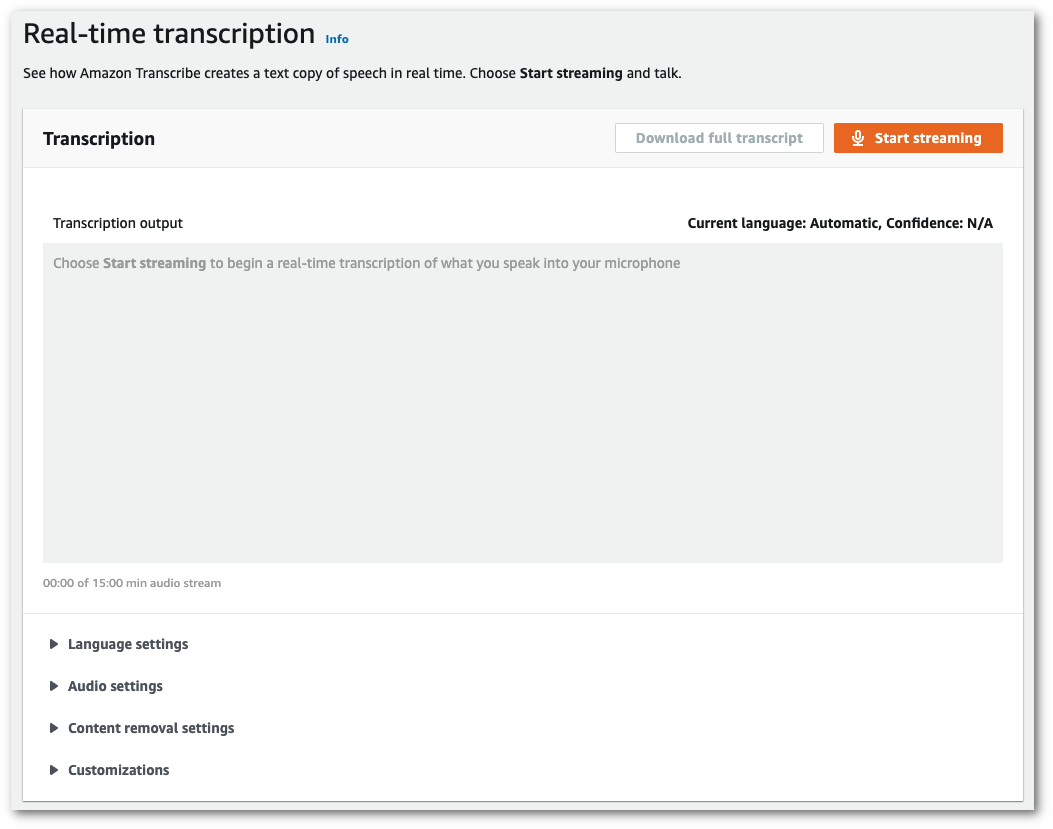Language identification with streaming transcriptions
Streaming language identification can identify the dominant language spoken in your media stream. Amazon Transcribe requires a minimum of one second of speech to identify the language.
If your stream contains only one language, you can enable single-language identification, which identifies the dominant language spoken in your media file and creates your transcript using only this language.
If your stream contains more than one language, you can enable multi-language identification, which identifies all languages spoken in your stream and creates your transcript using each identified language. Note that a multi-lingual transcript is produced. You can use other services, such as Amazon Transcribe, to translate your transcript.
To use streaming language identification, you must provide at least two language codes,
and you can select only one language dialect per language per stream. This means that you
cannot select en-US and en-AU as language options for the same
transcription.
You also have the option to select a preferred language from the set of language codes you provide. Adding a preferred language can speed up the language identification process, which is helpful for short audio clips.
Important
If none of the language codes you provide match the language, or languages, identified
in your audio, Amazon Transcribe selects the closest language match from your specified
language codes. It then produces a transcript in that language. For example, if your
media is in US English (en-US) and you provide Amazon Transcribe with the
language codes zh-CN, fr-FR, and de-DE,
Amazon Transcribe is likely to match your media to German (de-DE) and produce
a German-language transcription. Mismatching language codes and spoken languages can
result in an inaccurate transcript, so we recommend caution when including language
codes.
If your media contains two channels, Amazon Transcribe can identify the dominant language
spoken in each channel. In this case, set the ChannelIdentification parameter to true and each channel is
transcribed separately. Note that the default for this parameter is false. If
you don't change it, only the first channel is transcribed and only one language is
identified.
Streaming language identification can't be combined with custom language models or redaction. If combining language identification with other features, you are limited to the languages supported with those features, and also with streaming transcriptions. Refer to Supported languages.
Note
PCM and FLAC are the only supported audio formats for streaming language identification. For multi-language identification, only PCM is supported.
Identifying languages in multi-language audio
Multi-language identification is intended for multi-lingual streams, and provides you with a transcript that reflects all supported languages spoken in your stream. This means that if speakers change languages mid-conversation, or if each participant is speaking a different language, your transcription output detects and transcribes each language correctly.
For example, if your stream contains a bilingual speaker who is alternating between US
English (en-US) and Hindi (hi-IN), multi-language identification can
identify and transcribe spoken US English as en-US and spoken Hindi as
hi-IN. This differs from single-language identification, where only one dominant
language is used to create a transcript. In this case, any spoken language that is not the
dominant language is transcribed incorrectly.
Note
Redaction and custom language models are not currently supported with multi-language identification.
Using language identification with streaming media
You can use automatic language identification in a streaming transcription using the AWS Management Console, HTTP/2, or WebSockets; see the following for examples:
-
Sign in to the AWS Management Console
. -
In the navigation pane, choose Real-time transcription. Scroll down to Language settings and expand this field if it is minimized.

-
Select Automatic language identification or Automatic multiple languages identification.

-
Provide a minimum of two language codes for your transcription. Note that you can provide only one dialect per language. For example, you cannot select both
en-USandfr-CAas language options for the same transcription.
-
(Optional) From the subset of languages you selected in the previous step, you can choose a preferred language for your transcript.

-
You're now ready to transcribe your stream. Select Start streaming and begin speaking. To end your dictation, select Stop streaming.
This example creates an HTTP/2 request with language identification enabled. For more
information on using HTTP/2 streaming with Amazon Transcribe, see Setting up an HTTP/2 stream. For more detail on parameters and headers
specific to Amazon Transcribe, see StartStreamTranscription.
POST /stream-transcription HTTP/2 host: transcribestreaming.us-west-2.amazonaws.com X-Amz-Target: com.amazonaws.transcribe.Transcribe.StartStreamTranscriptionContent-Type: application/vnd.amazon.eventstream X-Amz-Content-Sha256:stringX-Amz-Date:20220208T235959Z Authorization: AWS4-HMAC-SHA256 Credential=access-key/20220208/us-west-2/transcribe/aws4_request, SignedHeaders=content-type;host;x-amz-content-sha256;x-amz-date;x-amz-target;x-amz-security-token, Signature=stringx-amzn-transcribe-media-encoding:flacx-amzn-transcribe-sample-rate:16000x-amzn-transcribe-identify-language: true x-amzn-transcribe-language-options:en-US,de-DEx-amzn-transcribe-preferred-language:en-UStransfer-encoding: chunked
This example creates an HTTP/2 request with multiple languages identification enabled. For more
information on using HTTP/2 streaming with Amazon Transcribe, see Setting up an HTTP/2 stream. For more detail on parameters and headers
specific to Amazon Transcribe, see StartStreamTranscription.
POST /stream-transcription HTTP/2 host: transcribestreaming.us-west-2.amazonaws.com X-Amz-Target: com.amazonaws.transcribe.Transcribe.StartStreamTranscriptionContent-Type: application/vnd.amazon.eventstream X-Amz-Content-Sha256:stringX-Amz-Date:20220208T235959Z Authorization: AWS4-HMAC-SHA256 Credential=access-key/20220208/us-west-2/transcribe/aws4_request, SignedHeaders=content-type;host;x-amz-content-sha256;x-amz-date;x-amz-target;x-amz-security-token, Signature=stringx-amzn-transcribe-media-encoding:flacx-amzn-transcribe-sample-rate:16000x-amzn-transcribe-identify-multiple-languages: true x-amzn-transcribe-language-options:en-US,de-DEx-amzn-transcribe-preferred-language:en-UStransfer-encoding: chunked
If you use identify-language or identify-multiple-languages in your request, you must also include
language-options. You cannot use both language-code and
identify-language in the same request.
Parameter definitions can be found in the API Reference; parameters common to all AWS API operations are listed in the Common Parameters section.
This example creates a presigned URL that uses language identification in a WebSocket
stream. Line breaks have been added for readability. For more information on using WebSocket
streams with Amazon Transcribe, see Setting up a WebSocket stream. For more detail on parameters, see
StartStreamTranscription.
GET wss://transcribestreaming.us-west-2.amazonaws.com:8443/stream-transcription-websocket? &X-Amz-Algorithm=AWS4-HMAC-SHA256 &X-Amz-Credential=AKIAIOSFODNN7EXAMPLE%2F20220208%2Fus-west-2%2Ftranscribe%2Faws4_request &X-Amz-Date=20220208T235959Z &X-Amz-Expires=300&X-Amz-Security-Token=security-token&X-Amz-Signature=string&X-Amz-SignedHeaders=content-type%3Bhost%3Bx-amz-date &media-encoding=flac&sample-rate=16000&identify-language=true &language-options=en-US,de-DE&preferred-language=en-US
This example creates a presigned URL that uses multiple languages identification in a WebSocket
stream. Line breaks have been added for readability. For more information on using WebSocket
streams with Amazon Transcribe, see Setting up a WebSocket stream. For more detail on parameters, see
StartStreamTranscription.
GET wss://transcribestreaming.us-west-2.amazonaws.com:8443/stream-transcription-websocket? &X-Amz-Algorithm=AWS4-HMAC-SHA256 &X-Amz-Credential=AKIAIOSFODNN7EXAMPLE%2F20220208%2Fus-west-2%2Ftranscribe%2Faws4_request &X-Amz-Date=20220208T235959Z &X-Amz-Expires=300&X-Amz-Security-Token=security-token&X-Amz-Signature=string&X-Amz-SignedHeaders=content-type%3Bhost%3Bx-amz-date &media-encoding=flac&sample-rate=16000&identify-multiple-languages=true &language-options=en-US,de-DE&preferred-language=en-US
If you use identify-language or identify-multiple-languages in your request, you must also include
language-options. You cannot use both language-code and
identify-language in the same request.
Parameter definitions can be found in the API Reference; parameters common to all AWS API operations are listed in the Common Parameters section.